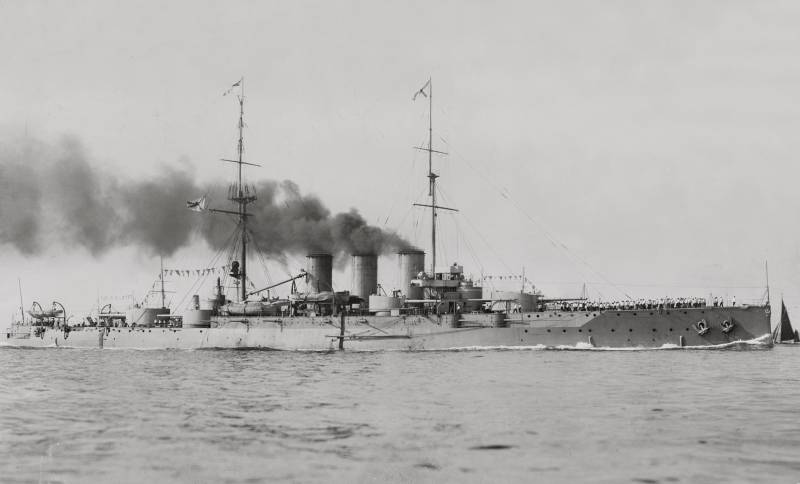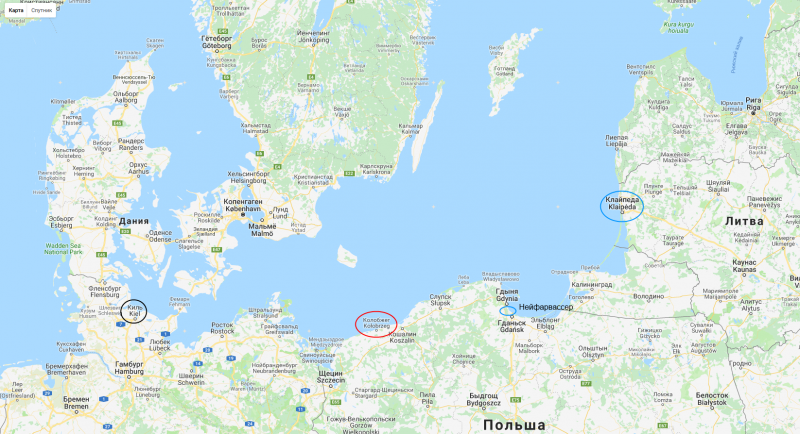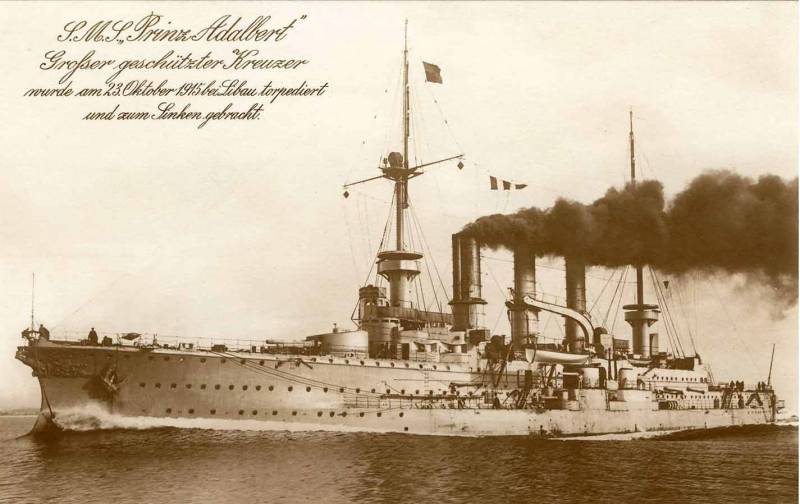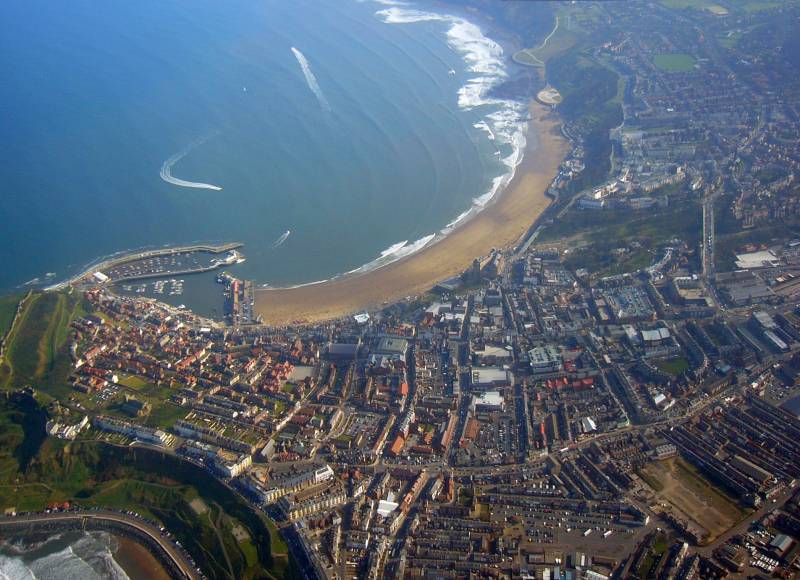Gotland bout 19 June 1915 g. Part of 1
What happened near the island of Gotland? In short, this was the case: the command of the Baltic Fleet decided to launch a raid of light forces with the aim of firing on the German city of Memel and sent a large force of cruisers to the southern part of the Baltic. The fog prevented the fulfillment of the task, but radio intelligence discovered the presence of German ships in the sea. Rear Admiral M.K. Bakhirev was able to intercept the German squad - against the two Russian armored ships and two large armored cruisers, the Germans had only a light Augsburg, the minelayer Albatross and three old destroyers. A battle ensued, as a result of which Augsburg and the destroyers were able to retreat, and the heavily damaged Albatross threw themselves on stones in neutral Swedish waters. Then the Russian detachment met with cover forces — the armored cruiser Roon and the light Lübeck. Possessing, in essence, superior forces, M.K. Bakhirev did not impose a decisive battle on the enemy, but preferred to call the powerful armored cruiser Rurik, he retreated. "Rurik" was able to intercept the German detachment, but it ended up even more embarrassing - despite the fact that the Russian cruiser was much stronger than both Germanic, he did not achieve any success. "Rurik" never hit the enemy and as a result, received minor damage, left the battlefield and did not pursue the enemy.
The battle of Gotland was the first and the last some serious clash of the Russian and German fleets on the high seas. According to its results, the Russians did not lose a single ship, but they themselves were forced to throw an enemy minelayer Albatros on the shore. It seems to be a victory - but given the overall superiority of the forces involved in this operation, many historians believe that the losses of the German fleet should have been much greater. The most common opinion on this battle today is that the Russian artillerymen were shooting very badly, the Russian commanders showed incompetence, and, moreover, they were afraid of the enemy, as a result, the Baltic Fleet missed an excellent opportunity to inflict a heavy defeat on the Germans. A.G. Patients so summarizes the results of the Gotland battle:
In the series of articles offered to your attention, we will try to figure out what really happened near the island of Gotland on a foggy summer day 19 June 1915 g (in the old style, which differs from today's calendar on 13 days). We will begin, as always from afar, because in order to understand certain actions of the Russian and German commanders in the Gotland battle, it is necessary to understand what was the situation and the balance of forces in the Baltic 1915 in the summer, as well as the goals and objectives that were set in front of him are the German and Russian fleets.
Of course, the Royal Navy remained the main problem of the Kaiserlichmarine, so the Germans concentrated their main forces in the North Sea. In the Baltic, they kept only a small detachment, the basis of which was already outdated warships, whose value in operations against the British was small, if not to say - insignificant. Of the modern ships in the Baltic, the Germans had only a few light cruisers and destroyers. Accordingly, the main tasks of the Germans in 1915 g were demonstration actions and support of the coastal flank of the army. The first was necessary in order to prevent the active operations of the Russian fleet, which, despite the fact that its core was made up of outdated ships, still significantly surpassed those forces that the Germans constantly kept in the Baltic. It was assumed that the active operations of the few German ships would force the Russians to think more about defense and not to carry out operations outside the Gulf of Finland and Riga - at this stage the Germans were quite happy. As for the second task, the German troops approached Libava and the Germans were interested in seizing this port city in order to base their ships there. Therefore, in the spring of 1915, the German fleet conducted systematic combat operations, mining the waters at the throat of the Gulf of Finland, invading light forces into the Gulf of Riga for demonstration operations, but most importantly they organized systematic support of their troops from Libava, without regretting the ships of the 4 reconnaissance group ( light cruisers and destroyers) and the 4 squadron of battleships (old battleships) for cover, which the latter carried out while in Kiel. In the end, Libava was captured, the next target of the Germans was Vindava. The Russian 5 army in Kurland could not hold back German troops and gradually rolled back towards Riga. Accordingly, the coastal flank of the armies gradually moved towards the Gulf of Riga.
The Russians in the Baltic were stronger, but they didn’t carry out any large operations. In addition to the defense of the Gulf of Finland and Riga, the Baltic Fleet put minefields at Libau and Vindava, Russian and British submarines constantly went to sea. But surface ships showed a certain passivity, although the 5 and 6 battalions of destroyers, together with the Okun submarine, quite successfully "crumpled" the bombardment of Windawa, undertaken by a detachment of the coast guard "Beowulf", light cruisers "Lübeck", and light-weight cruisers "Lübeck", I-lamers, lightweight cruisers "Lübeck", I-lamers, lightweight cruisers "Lübeck", I-lamers, lightweight cruisers "Lübeck", I-lamers, lightweight cruisers "Lübeck", I-lamers, lightweight cruisers "Lübeck", I-liter, I am lightweight. As well as three destroyers and six minesweepers. The first brigade of cruisers went to the laying of mines to Libau and had a short night skirmish with the German cruiser “Munich”, which, however, did not lead to anything.
Such inaction of the Baltic Imperial Fleet was due to three factors. The first of these was that, despite the presence of the signal book of the German cruiser Magdeburg who died on the stones and the ability to read German radiograms, the command never knew exactly what the German fleet had in the Baltic. It is well known that the Germans at any time could transfer many times superior forces along the Kiel Canal from the North Sea to the Baltic.
The second factor is the absence of modern high-speed ships in the Russian fleet, with the exception of the one and only oil destroyer Novik. Absolutely all the Baltic cruisers, starting from the “Diana” and ending with the armored cruisers of the new construction like “Bayan” and “Rurik”, had a speed up to the 21 node. Thus, they did not have enough speed to evade combat with modern dreadnoughts and, of course, they did not have combat power and protection to withstand the latter. In other words, each exit of domestic cruisers in the sea represented a game with death.
And finally, the third factor is the unavailability of the Sevastopol battleship brigade. Formally, all four ships of this type were put into operation in the autumn and winter of 1914 g, but they did not have time to complete the course of combat training before the Gulf of Finland freezing (February 1915g). Having resumed military training at the end of April, they were still not ready "for a campaign and battle" in the early summer of 1915. I must say that von Essen believed that after gaining full combat readiness, "Sevastopoli" would allow him to conduct active, offensive actions at sea . He hoped to lead them at sea and use them to cover the operations of the old cruisers. But while the regrettable situation was developing - “Sevastopoli” could not be sent into battle because of their unavailability, and the old battleships of the Baltic Fleet - “Glory”, “Tsesarevich”, “Emperor Paul I” and “Andrew the First-Called” could not be sent into battle too, because that the dreadnoughts are not yet ready, it was they who provided the defense of the central mine-artillery position that defended the throat of the Gulf of Finland. All that the commander of the fleet was able to do - in February 1915 r "knock out" from the Stavka permission to use two battleships-dodrednouta outside the Gulf of Finland.
Unfortunately, the 7 in May, the 1915 of the Baltic Fleet suffered a terrible loss - the commander of the Baltic Fleet, von Essen, died from a croupic pneumonia. He was to be replaced by an experienced and enterprising officer — Ludwig Berberhardovich Kerber, but he was “pushed” —on spying and intolerance towards people with German surnames started in the country. Against brother LB Kerber was made completely absurd charges, which were later abandoned, but the admiral was compromised by this. The vice-admiral Vasily Alexandrovich Kanin was appointed to the post of the 14 commander of May, who in his qualities was much inferior to the commander N.O. Essen and LB Kerberu
Nevertheless, perhaps the first thing that VA did. Kanin, having assumed the position of a fleet commander, asked permission from the Stavka to use Sevastopol-type battleships for offensive operations, but he was denied. However, in fairness it should be noted that the request of V.A. Kanin about Sevastopol, apparently, had a demonstrative, image character - in 1916 g, when all restrictions on the use of the latest dreadnoughts were removed by the Stake, he never used them to cover active actions of cruisers in the open sea. On the other hand, V.A. Obviously, Kanin understood that it would be impossible for him to avoid comparison with the untimely deceased Nikolai Ottovich von Essen, and that in order to increase his reputation he should undertake something, some kind of operation that would strengthen his faith in him, as in a capable commander.
That was the situation in which the planning of the raid on Memel was carried out, and it happened this way. The plan of operation did not originate in the higher hierarchies of the command, but, one might say, “on the ground”, more specifically: in the department of Rear Admiral A.I. Nepenina, Head of the Baltic Sea Communication Service. This service, in fact, was a Baltic Fleet radio survey. And so, 17 June 1915 r (we’ll talk about the exact date later) the communications service reported the command of the fleet the text of the intercepted German radiogram, from which it followed that all German warships were returning to bases, and even the sentinel destroyers were replaced with improvised trawlers - armed trawlers. The intelligence report of the headquarters of the Baltic Fleet No.11-12 (from 17 June to 7 July) in part of the “Intention of the enemy” read:
Thus, it became clear that the Baltic Fleet would be able to use its relatively low-speed ships for conducting operations at German shores, practically without fear of interception. And now the senior flag officer of the operational section of the headquarters of the commander of the Baltic Fleet, Lieutenant A.A. Sakovich and the second (radio-telegraph) flagship mine officer (in fact, the radio intelligence officer), Senior Lieutenant I.I. Rengarten had an idea:
Thus, initially this operation had moral, not military significance, which, nevertheless, was not worth minimizing. The fact is that anxiety sentiment increasingly prevailed in public opinion in Germany, and there were many reasons for this. First, in spite of all the pre-war plans and no matter how the supreme military command sought, the country could not avoid a war on two fronts, which, obviously, it had to be avoided by all means. Secondly, there was no prospect of a quick victory on at least one of the fronts. The “lightning fast” campaign in France obviously did not work out, and there it was not worth waiting for quick results, and the hope to defeat the Russians in 1915 g melted much faster than March snow. Despite a number of severe defeats and the beginning of the “great retreat,” the armies of the Russian Empire were not completely defeated and “snapped” painfully at any convenient moment. Austro-German troops were enough to close the Russian regiments, but not enough to achieve decisive results, and there was no place to take new troops. Third, (and this was probably more important than the first and second), although it was still very far from hunger, but the first problems with food began in Germany exactly in 1915. Our agents in Germany repeatedly stated that:
In general, it can be stated that the time of the imperial parade in Kiel, which the Kaiser himself was supposed to attend, was perfectly suited for such an action.
According to the plan A.A. Sakovich and I.I. Rengarten bombing should have been carried out by the cruisers together with the Rurik, the most powerful ship of this class in our Baltic fleet. As an object of attack, the lieutenants suggested Kolberg (today - Kolobrzeg). This city, located on the coast of East Prussia, as will be shown below, was very well suited for the action they had planned.
With their plan, the lieutenants turned to the flag captain for the operational part of the captain of the 1 rank A.V. Kolchak (the same one), and he fully approved it, noting only that the object of attack requires additional discussion. Then the officers turned to the fleet chief of staff with this project (in his memoirs, AA Sakovich mentions that LB Kerber was still at that time, but there could be a mistake, since he took command of the squadron in June 1915 G dreadnoughts), and he, too, praised the plan and considered that it must be urgently and urgently implemented.
So, having passed through the chain of superiors and earning their approval, the project of an attack on Kohlberg came to the commander of the fleet, V.A. Kaninu. A meeting was immediately gathered, in which, in addition to the fleet, the flag officer, the chief of staff and the entire operational unit took part.
But Vasily Aleksandrovich was careful. First, he considered the raid on Kohlberg too dangerous, and replaced Kohlberg with Memel (now Klaipeda). Generally speaking, Memel is a Lithuanian city, and for its existence it was replaced by many gentlemen, but starting from 1871 g it was considered the most northern city of the proclaimed German Empire.
However, Kolberg was much better suited to attack, and this was well explained in his memoirs by A.A. Sakovich:
In addition, V.A. Kanin categorically refused to use the Rurik in this operation, not wanting to risk the best cruiser of the Baltic Fleet.
It should be noted that such decisions characterize V.A. Kanina is not at its best. Below we give a map, on which, for the convenience of a respected reader, Kiel is marked with a black circle, Kohlberg with a red circle, and Neyfarwasser and Memel with a blue circle.
The change in the objective of the operation reduced the route to it from approximately nautical miles from 370 to 300, and this is not the distance for which Kolberg had to sacrifice in favor of a much less significant Memel. In addition, one glance at the map showed that ships from Kiel, even if German battlecruisers were in it, would have no chance to intercept the Russian detachment after the shelling of Kohlberg - from it to Kiel by sea almost 200 miles. In essence, if something could threaten the Baltic Fleet cruisers, it is some German naval forces remaining in Libau or Neufarvasser. But, being in Libau, in any case they would have been between the Russian ships and the Gulf of Finland, the choice of Memel instead of Kohlberg had no effect on this. And to intercept the Russians from Neufarvasser, if they went to shoot at Kohlberg ... Theoretically, this was possible, but practically — almost unrealistic, because for this you would need to have warships under pairs, in three minutes ready to go, that chance. At the same time, in fact, the German ships that came out of 19 on June 1915 from Neufarwasser to help the ships of Carf took only four hours to separate the pairs - by this time the Russian detachment that had fired at Kolberg would have been halfway to Gotland island.
And in any case, neither in Libau, nor in Neufarwasser could one expect anything more terrible than the German armored cruisers.
However, for the 1 Brigade of the Baltic Fleet cruisers, they posed a serious threat, because individually they were much stronger than the Bayan and Admiral Makarov, not to mention the armored Bogatyr and Oleg. If suddenly there were three such ships in Libava: the Roon, Prince Heinrich and Prince Adalbert, they could not only intercept the Russian squadron, but also destroy it, or at least inflict heavy losses on it. In order to avoid this, it was precisely what should have been included in the Rurik squadron, because for this ship, designed after the Russian-Japanese war, any German armored cruiser (at least in theory) was nothing more than " legal booty. " Comparing the tactical and technical characteristics of the Rurik and the German armored cruisers, we see that even the two German ships were hardly the same as the Rurik.
Summarizing the above, it turned out that the only threat to the ships participating in the raid were the German armored cruisers in Libau (if they were there, which nobody knew exactly). The inclusion of “Rurik” in the Russian squad would completely neutralize this threat, but this is precisely what V.A. Kanin did not want to do! Fearing for the fate of his strongest cruiser, he put the 1 cruiser brigade at all to an unnecessary risk. The remaining officers of the headquarters and the operations department understood this perfectly well, and tried to dissuade the newly-made comflot from such rash decisions. The meeting lasted five hours and ended only at 2 in the morning! However, “persuade” V.A. Kanina managed only partially. Here is how A.A. describes this meeting. Sakovich:
The blind case tipped the scales in the opposite direction. Rengarten, known for his perseverance, seeing that everything was falling apart, lost patience and said some harsh phrase on another dull replica of the commander. The result was unexpected. Did Kanin understand at that moment what he was trying to prove during 5 hours in a row, or was he just tired of the lengthy discussion, but he suddenly gave way to Rurik, saying a very characteristic phrase for him: “Well, well, Ivan Ivanovich (Rengarten) is angry, I will give you "Rurik". " The object of the operation, he still left Memel, which, as has already been said, significantly reduced the integrity and significance of the original operational plan. ”
However, the decision was made and the purpose of the operation was formulated as follows:
I would like to note a funny incident in the sources: for example, Kozlov D.Yu. in the “Memel operation of the Baltic Sea fleet” indicates (and we talked about this earlier) that the command of the Baltic Fleet received information about the return of all ships to the 17 base on June 1915 g (old style), and at the same time its description and memories .BUT. Sakovich lead to the fact that:
1) A.A. Sakovich and I.I. Rengarten received a telegram from the Germans and began work on drawing up the plan on June 17, and on the same day they submitted a draft plan to their leadership.
2) At 21.00 on the same day, a meeting began with V.A. Kanin.
3) The meeting lasted 5 hours and ended at 02.00, i.е. at 2 o'clock in the afternoon.
From this, it seems, that the decision to conduct the operation was taken on 18 June. But why then the same D.Yu. Kozlov points out that according to the revised plan, the operations of the ships were to go to sea on June 17-18 (backdating?), And that the detachment was to assemble at the Vinkov bank around 05.00, i.e. just three hours after the meeting? And then the distinguished author reports that M.K. Bakhirev, the detachment commander, received an order from the 17 squadron of June, and the bunkering (loading of coal) before the operation was completed on June 17 in 17.52?
According to the author of this article, an annoying mistake occurred - the German telegram was deciphered not on 17, but on June 16, then everything converges - the results of its analysis fall into intelligence on June 17 - on July 7, to the development of the AA raid plan. Sakovich and I.I. Rengarten does not start on 17, but on June 16, a five-hour meeting, at which it was decided to conduct the operation on the night of 16 on June 17, and starting from early morning on June 10, ships are being prepared in the sea. If we assume that there is no error in the sources, then we will have to admit that the two lieutenants, having invented something themselves, managed to give all the necessary orders to conduct the operation even before they informed their superiors about their projects as if they come from a fleet.
Accordingly, we will focus on the fact that the decision to conduct the operation was made on the night of 16 and 17 in June. But before proceeding to the description of the plan of operation, we will mention more about ... its ethical side.
The fact is that AG Patients, commenting on the purpose of the Russian operation, writes:
However, there is a nuance. The fact is that the raid on Whitby and Scarborough looked like this - Derflinger and Von der Tann, coming out of the fog strip, lay parallel to the coastline in some 10 cables from it - and, going from Whitby to Scarborough, opened fire. At the same time, the Germans were shooting precisely at the cities - both of them are small settlements, there are no ports (except for those marinas for yachts and fishing vessels) or military facilities there. In other words, the Germans deliberately deliberately attacked the civilian "non-combatants."
At the same time, the Russians did not intend to shoot at the city, but planned the shelling of port facilities. According to A.K. Weiss:
It is possible that for many of us, whose perception of the ethics of military operations was shaped through the hellish prism of the Second World War, with its countless villages and cities that had been burned to the ground, this would seem to be some sort of posturing, but ... Then there was another time, and in any case an artillery strike on structures The military port is fundamentally different from the shelling of residential areas.
To be continued!




Information